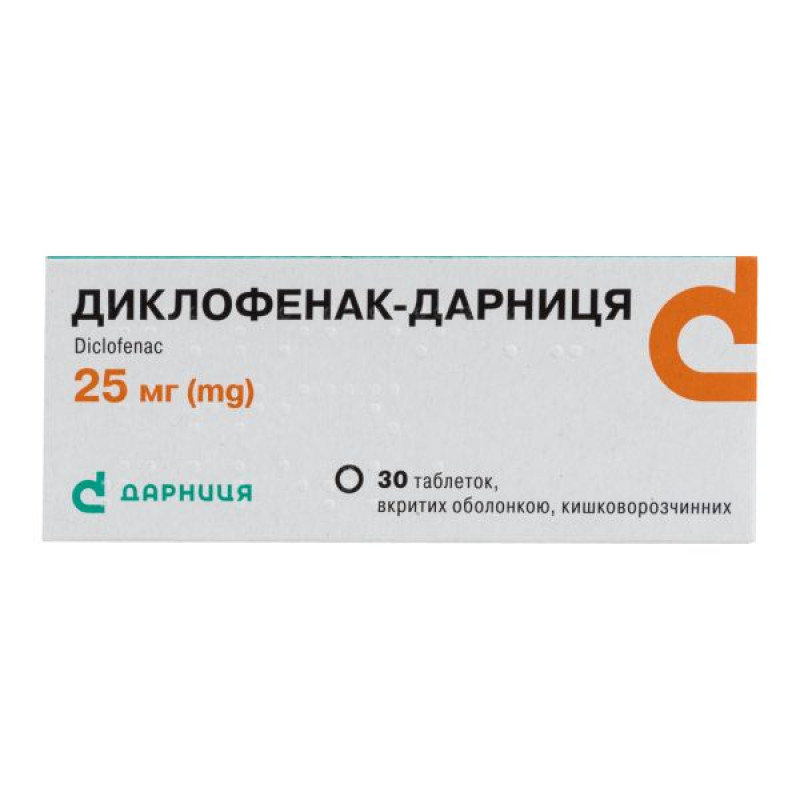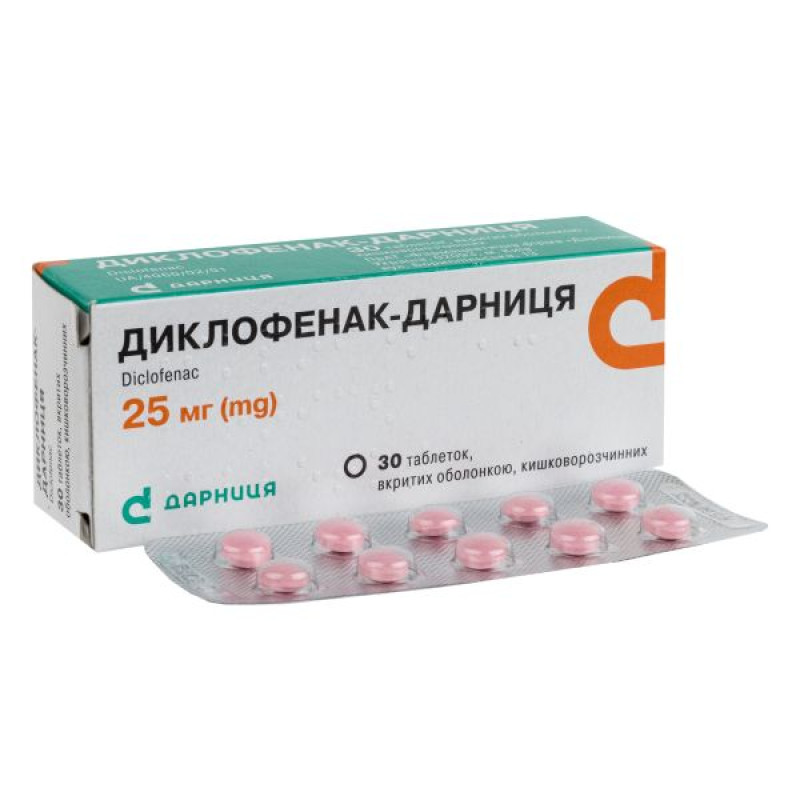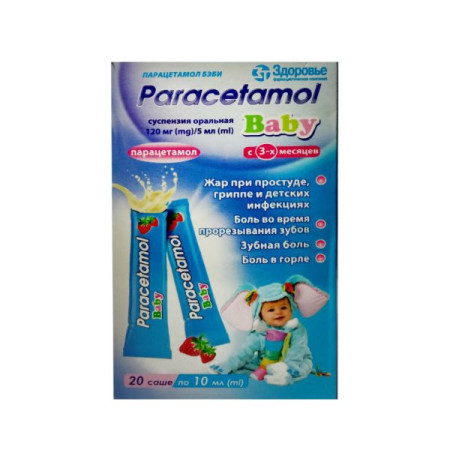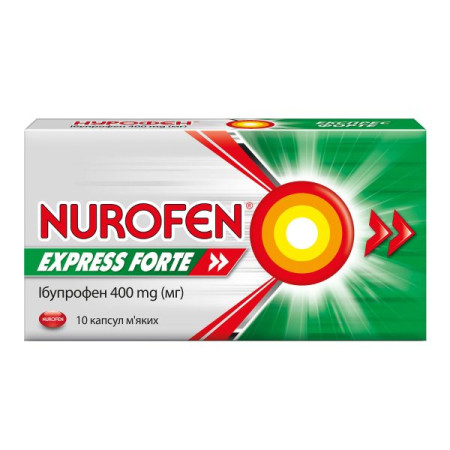Diclofenac-Darnitsa enteric-coated tablets 25 mg No. 30
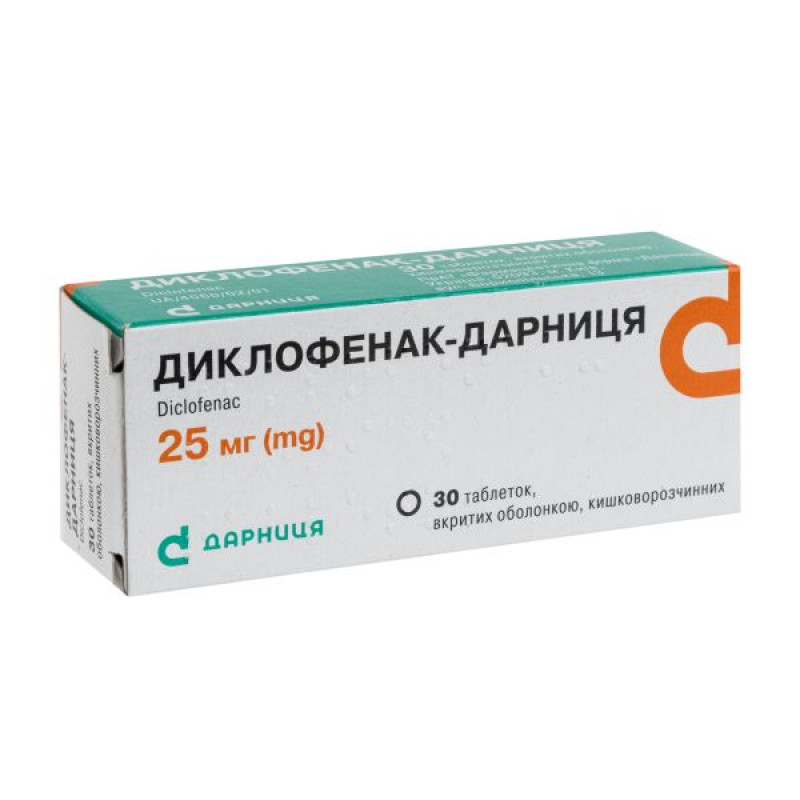
Instructions for Diclofenac-Darnitsa enteric-coated tablets 25 mg No. 30
Composition
active ingredient: diclofenac;
1 tablet contains diclofenac sodium 25 mg;
excipients: lactose monohydrate, microcrystalline cellulose, corn starch, colloidal anhydrous silica, talc, magnesium stearate; methacrylate copolymer dispersion, propylene glycol, talc, titanium dioxide (E 171), carmoisine (E 122).
Dosage form
The film-coated tablets are enteric-coated.
Main physicochemical properties: film-coated tablets, pink in color, with a biconvex surface, enteric-coated. Two layers are visible on the cross-section.
Pharmacotherapeutic group
Nonsteroidal anti-inflammatory and antirheumatic drugs. Acetic acid derivatives and related compounds. ATC code M01A B05.
Pharmacological properties
Pharmacodynamics.
Diclofenac-Darnitsa contains diclofenac sodium, a nonsteroidal compound with pronounced antirheumatic, anti-inflammatory, analgesic and antipyretic effects. The main mechanism of action of diclofenac is considered to be inhibition of prostaglandin biosynthesis. Prostaglandins play an important role in the genesis of inflammation, pain and fever.
In rheumatic diseases, the anti-inflammatory and analgesic properties of the drug provide a clinical effect characterized by a significant reduction in the severity of such symptoms and complaints as pain at rest and during movement, morning stiffness, joint swelling, as well as improved joint function.
In vitro, diclofenac sodium at concentrations equivalent to those achieved in the treatment of patients does not inhibit the biosynthesis of cartilage proteoglycans.
In post-traumatic and postoperative inflammatory phenomena, diclofenac quickly relieves pain (both at rest and that which occurs during movement), reduces inflammatory edema and postoperative wound swelling.
Clinical studies have shown a significant analgesic effect of the drug in moderate to severe pain syndrome of non-rheumatic origin. Clinical studies have also shown that diclofenac is able to eliminate pain and reduce the severity of blood loss in primary dysmenorrhea.
Diclofenac also has a therapeutic effect on migraine attacks.
Pharmacokinetics.
Absorption. After oral administration, the active substance, diclofenac, is rapidly and completely absorbed. Food reduces the rate of absorption, but the amount of active substance absorbed does not change.
After a single oral dose of 50 mg diclofenac, the maximum concentration is reached after approximately 2 hours and is 1.5 μg/ml (5 μmol/l). The amount of active substance absorbed is linearly proportional to the dose.
The passage of the tablet through the stomach is slowed down if the drug is taken during or after food (compared to taking it before food), but the amount of diclofenac absorbed is not changed. Since approximately half of the dose of diclofenac is metabolized during the first passage through the liver (first-pass effect), the area under the concentration-time curve (AUC) after oral or rectal administration is approximately half of the area in the case of parenteral administration of an equivalent dose. If the recommended dosing interval is observed, accumulation of the drug was not observed.
Plasma drug concentrations achieved in children at equivalent doses (mg/kg body weight) are similar to those observed in adults.
Distribution. 99.7% of diclofenac binds to plasma proteins, mainly albumin (99.4%). The apparent volume of distribution is 0.12 to 0.17 l/kg. Diclofenac penetrates into the synovial fluid, where it reaches maximum concentrations after 3-6 hours. 2 hours after reaching peak plasma concentrations, the levels of the active substance are already higher in the synovial fluid than in the blood plasma, and remain higher for up to 12 hours.
Biotransformation. The biotransformation of diclofenac occurs partly by glucuronidation of the parent molecule, but mainly by single and multiple hydroxylation and methoxylation, leading to the formation of several phenolic metabolites (3'-hydroxy-, 4'-hydroxy-, 5-hydroxy-, 4',5-dihydroxy- and 3'-hydroxy-4'-methoxy-diclofenac), most of which are converted to glucuronide conjugates. Two of these phenolic metabolites are biologically active, but to a lesser extent than diclofenac.
Elimination. The total systemic clearance of diclofenac from plasma is 263 ± 56 ml/min (mean ± standard deviation). The terminal plasma half-life is 1 to 2 hours. Four of the metabolites, including two active ones, also have short plasma half-lives. The plasma half-life of one of the metabolites, 3'-hydroxy-4'-methoxy-diclofenac, is much longer; however, this metabolite is virtually inactive.
Pharmacokinetics in different patient groups. No significant differences in absorption, metabolism, or excretion of the drug were observed depending on the age of the patients.
In patients with renal insufficiency, accumulation of unchanged active substance is unlikely based on single dose kinetics when the usual dosing regimen is followed. In the case of creatinine clearance < 10 ml/min, the calculated steady-state plasma concentrations of hydroxymetabolites are approximately 4 times higher than in healthy subjects. Thus, the metabolites are ultimately excreted in the bile.
In patients with chronic hepatitis or compensated cirrhosis, the kinetics and metabolism of diclofenac are the same as in patients without liver disease.
Indication
Inflammatory and degenerative forms of rheumatic diseases (rheumatoid arthritis, ankylosing spondylitis, osteoarthritis, spondyloarthritis).
Pain syndromes in the spine.
Non-articular rheumatism.
Acute attacks of gout.
Post-traumatic and postoperative pain syndrome accompanied by inflammation and swelling, for example after dental and orthopedic interventions.
Gynecological diseases that are accompanied by pain and inflammation, such as primary dysmenorrhea or adnexitis.
As an adjunct in severe inflammatory diseases of the ENT organs, which are accompanied by pain, for example, in pharyngotonsillitis, otitis. In accordance with general therapeutic principles, the underlying disease should be treated with basic therapy. Fever in itself is not an indication for the use of the drug.
Contraindication
Hypersensitivity to the active substance or to any other components of the medicinal product.
Diclofenac-Darnitsa, like other nonsteroidal anti-inflammatory drugs (NSAIDs), is contraindicated in patients who experience attacks of bronchial asthma, urticaria or acute rhinitis, nasal polyps, and other allergic symptoms in response to the use of acetylsalicylic acid or other NSAIDs.
The last trimester of pregnancy.
Acute stomach or intestinal ulcer; gastrointestinal bleeding or perforation.
Inflammatory bowel disease (Crohn's disease or ulcerative colitis).
Severe liver failure (Child-Pugh class C, cirrhosis or ascites).
Severe renal failure (creatinine clearance <30 ml/min).
Congestive heart failure (NYHA II-IV).
Ischemic heart disease in patients with angina pectoris or previous myocardial infarction.
Cerebrovascular disease in patients who have had a stroke or have episodes of transient ischemic attacks.
Peripheral artery disease.
Treatment of postoperative pain after coronary artery bypass graft surgery (or use of a cardiopulmonary bypass machine).
History of gastrointestinal bleeding or perforation related to previous treatment with nonsteroidal anti-inflammatory drugs (NSAIDs).
Active ulcer/bleeding or history of recurrent ulcer/bleeding (two or more separate episodes of established ulceration or bleeding).
Interaction with other medicinal products and other types of interactions
The following types of interactions have been observed with diclofenac medicinal products in the form of a solution for injection and/or other dosage forms.
Lithium: Diclofenac may increase plasma lithium concentrations when used concomitantly. Monitoring of serum lithium levels is recommended.
Digoxin: Diclofenac may increase plasma concentrations of digoxin when used concomitantly. Monitoring of serum digoxin levels is recommended.
Diuretics and antihypertensives: As with other NSAIDs, concomitant use of diclofenac with diuretics or antihypertensives (e.g. β-blockers, angiotensin-converting enzyme (ACE) inhibitors) may lead to a reduction in their antihypertensive effect. Therefore, such a combination should be used with caution and patients, especially the elderly, should be closely monitored for blood pressure.
Patients should be adequately hydrated and monitoring of renal function is recommended after initiation of concomitant therapy and regularly thereafter, especially with diuretics and ACE inhibitors due to the increased risk of nephrotoxicity.
Medicinal products known to cause hyperkalaemia. Concomitant treatment with potassium medicinal products may be associated with increases in serum potassium levels, requiring close monitoring of patients.
Other NSAIDs and corticosteroids: Concomitant administration of diclofenac and other systemic NSAIDs or corticosteroids may increase the incidence of gastrointestinal adverse reactions.
Anticoagulants and antithrombotic agents: Caution is advised as concomitant administration may increase the risk of bleeding. Although clinical studies have not shown an effect of diclofenac on the activity of anticoagulants, there is some evidence of an increased risk of bleeding in patients receiving diclofenac and anticoagulants concomitantly, and close monitoring of such patients is recommended.
Selective serotonin reuptake inhibitors (SSRIs): Concomitant administration of systemic NSAIDs and SSRIs may increase the risk of gastrointestinal bleeding.
Antidiabetic drugs. Diclofenac can be used with oral antidiabetic drugs without affecting their clinical effect. However, isolated cases of both hypoglycemic and hyperglycemic effects have been reported, requiring a change in the dosage of antidiabetic drugs during treatment with diclofenac. Such conditions require monitoring of blood glucose levels, which is a precautionary measure during concomitant therapy.
Colestipol and cholestyramine. These drugs may delay or reduce the absorption of diclofenac. Therefore, it is recommended to take diclofenac at least 1 hour before or 4-6 hours after taking colestipol/cholestyramine.
Medicinal products that induce drug-metabolizing enzymes: Enzyme-inducing medicinal products, such as rifampicin, carbamazepine, phenytoin, St. John's wort (Hypericum perforatum), are theoretically capable of reducing diclofenac plasma concentrations.
Methotrexate: Caution is advised when administering NSAIDs less than 24 hours before or after treatment with methotrexate, as blood concentrations of methotrexate may increase and toxicity of this substance may increase.
Cyclosporine and tacrolimus. Diclofenac, like other NSAIDs, may increase the nephrotoxicity of cyclosporine through its effects on renal prostaglandins. This risk is increased in patients treated with tacrolimus. Therefore, it should be used in lower doses than in patients not receiving cyclosporine.
Quinolone antibiotics: There have been isolated reports of convulsions, which may be associated with the concomitant use of quinolones and NSAIDs.
Potent CYP2C9 inhibitors: Caution should be exercised when diclofenac is co-administered with CYP2C9 inhibitors (such as sulfinpyrazone and voriconazole), as this may result in a significant increase in peak plasma concentrations and exposure to diclofenac due to inhibition of diclofenac metabolism.
Phenytoin: When using phenytoin concomitantly with diclofenac, it is recommended to monitor the plasma concentration of phenytoin due to a possible increase in the exposure of phenytoin.
Cardiac glycosides. Concomitant use of cardiac glycosides and NSAIDs may exacerbate heart failure, reduce glomerular filtration rate, and increase plasma glycoside levels.
Mifepristone: NSAIDs should not be used for 8–12 days after mifepristone administration, as NSAIDs may reduce the effect of mifepristone.
Application features
General precautions regarding the use of systemic nonsteroidal anti-inflammatory drugs (NSAIDs).
To reduce the risk of gastrointestinal ulceration, bleeding or perforation, which may occur at any time during treatment with NSAIDs, regardless of their selectivity for COX-2 and even in the absence of warning symptoms or predisposing factors in history, the lowest effective dose should be used for the shortest possible period of time.
Patients with gastrointestinal disorders, liver dysfunction, or a history of suspected gastric or intestinal ulcers should only use this medicine if absolutely necessary and under close medical supervision.
An increased risk of thrombotic cardiovascular and cerebrovascular events has been reported with certain selective COX-2 inhibitors. It is currently unclear whether this risk is directly related to the COX-1/COX-2 selectivity of individual NSAIDs.
Diclofenac should only be prescribed to patients with significant risk factors for cardiovascular events (e.g. hypertension, hyperlipidemia, diabetes mellitus, smoking) after careful clinical evaluation. Since the cardiovascular risks of diclofenac may increase with increasing dose and duration of treatment, it should be used for the shortest possible period of time and at the lowest effective dose. The patient's need for diclofenac should be periodically reviewed for symptom relief and response to therapy. Use with caution in patients over 65 years of age.
The effect of NSAIDs on the kidneys causes fluid retention and edema and/or arterial hypertension, therefore diclofenac should be used with caution in patients with cardiac disorders or other conditions in which there is a tendency to fluid retention. Use the drug with caution in patients who are concomitantly using diuretics or ACE inhibitors or who are at increased risk of developing hypovolemia.
Very rarely, severe skin reactions (in some cases fatal), including exfoliative dermatitis, Stevens-Johnson syndrome and toxic epidermal necrolysis, have been reported in association with the use of NSAIDs. Patients are at greatest risk of developing such reactions at the beginning of treatment, and these reactions usually occur within the first month of treatment. Diclofenac should be discontinued at the first appearance of rash, mucosal lesions or any other sign of hypersensitivity.
SLE and mixed connective tissue diseases.
Patients with systemic lupus erythematosus (SLE) and mixed connective tissue diseases may be at increased risk of developing aseptic meningitis.
As with all analgesics, prolonged use of a drug for the treatment of headache may result in improvement or worsening of the condition (medication overuse headache). If headache is due to analgesic overuse, the dose of analgesics should not be increased; in such cases, treatment should be discontinued. Medication overuse headache should be suspected in patients with frequent or daily attacks of headache that occur despite (or because of) regular analgesic use.
As with other NSAIDs, allergic reactions (including anaphylactic/anaphylactoid reactions) may rarely occur, even without prior use of diclofenac. Like other NSAIDs, Diclofenac-Darnitsa, due to its pharmacodynamic properties, may mask the signs and symptoms of infection.
Reservation.
General.
Diclofenac-Darnitsa and other systemic NSAIDs, including selective COX-2 inhibitors, should not be used simultaneously, as there is no evidence of the benefits of synergistic action, as well as due to the occurrence of additional side effects.
The drug should be used with caution in elderly patients. In particular, it is recommended to prescribe the lowest effective dose in physically frail elderly patients or if the patient's body weight is below normal.
History of bronchial asthma.
Patients with bronchial asthma, seasonal allergic rhinitis, swelling of the nasal mucosa (e.g. nasal polyps), chronic obstructive pulmonary disease (COPD) or chronic respiratory tract infections (especially with manifestations similar to symptoms of allergic rhinitis) when taking NSAIDs are more likely than other patients to experience side effects such as exacerbation of bronchial asthma (so-called analgesic intolerance or analgesic asthma), angioedema, urticaria. In this regard, special precautions (readiness to provide emergency care) are necessary for such patients. The above also applies to patients with allergic manifestations (e.g. rash, itching, urticaria) when using other drugs.
Effects on the digestive tract (GT).
As with other NSAIDs, close medical supervision and special caution are necessary when prescribing the drug to patients with symptoms suggestive of gastrointestinal disorders or ulceration; history of gastric or intestinal bleeding or perforation. The risk of gastrointestinal bleeding increases with increasing NSAID doses, as well as in patients with a history of ulcer, especially if complicated (bleeding or perforation), and in elderly patients. To reduce the risk of toxic effects on the TT in such patients, treatment should be initiated and maintained at the lowest effective dose. For such patients, as well as for patients who require concomitant use of drugs containing acetylsalicylic acid or other drugs that increase the risk of harmful effects on the TT, combination therapy with the use of protective agents (e.g. proton pump inhibitors or misoprostol) should be considered. Patients with a history of TT toxicity, especially the elderly, should report any unusual abdominal symptoms (especially TT bleeding) to their physician. Use with caution in patients receiving concomitant medications that may increase the risk of ulceration or bleeding (systemic corticosteroids, anticoagulants, antithrombotic agents, or selective serotonin reuptake inhibitors).
Effect on the liver.
Patients with liver impairment should be monitored closely as their condition may worsen.
It should be noted that Diclofenac-Darnitsa is recommended only for short-term treatment (no more than 2 weeks). In the case of long-term use of diclofenac, regular monitoring of liver function is a precautionary measure. The use of this medicinal product should be discontinued if liver function is impaired or worsened, if clinical signs or symptoms suggestive of liver disease develop, or if other symptoms occur, such as eosinophilia, rash. Hepatitis may occur without prodromal symptoms.
In addition to elevated liver enzymes, severe hepatic reactions, including jaundice and fulminant hepatitis, hepatic necrosis and hepatic failure, some of which were fatal, have been reported rarely.
Diclofenac should be used with caution in patients with hepatic porphyria due to the possibility of provoking an attack.
Effect on the kidneys.
Long-term use of high doses of NSAIDs often leads to edema and hypertension.
Particular caution should be exercised in patients with cardiac or renal impairment, a history of hypertension, elderly patients, patients who are concomitantly taking diuretics or drugs that have a significant effect on renal function, and patients with a significant decrease in extracellular fluid volume, for example before/after surgery. When prescribing Diclofenac-Darnitsa in such cases, renal function should be monitored. After discontinuation of therapy, the patient's condition usually normalizes.
Effect on hematological parameters.
Diclofenac-Darnitsa is recommended for short-term treatment only. If this medicine is prescribed for a longer period, it is recommended (as for other NSAIDs) to regularly monitor the blood count.
Like other NSAIDs, diclofenac may temporarily inhibit platelet aggregation, so patients with impaired hemostasis should be carefully monitored.
Diclofenac-Darnitsa contains lactose, therefore it should not be used in patients with rare hereditary forms of galactose intolerance, lactase deficiency or glucose-galactose malabsorption syndrome.
You should not drink alcohol during treatment.
Use during pregnancy or breastfeeding
The use of diclofenac in pregnant women has not been studied. Animal studies do not indicate any direct or indirect toxic effects with respect to pregnancy, embryonic development, fetal development, parturition and/or postnatal development.
In the I and II trimesters of pregnancy, Diclofenac-Darnitsa, enteric-coated tablets, should be prescribed only if the expected benefit to the mother outweighs the potential risk to the fetus and only in the minimum effective dose. As with other NSAIDs, the drug is contraindicated in the last trimester of pregnancy (possible inhibition of uterine contractility and premature closure of the ductus arteriosus in the fetus).
Inhibition of prostaglandin synthesis may have adverse effects on pregnancy and/or embryo/foetal development. Epidemiological data suggest an increased risk of miscarriage and/or cardiac malformations and gastroschisis following use of a prostaglandin synthesis inhibitor in early pregnancy. The absolute risk of cardiovascular malformations was increased from less than 1% to approximately 1.5%.
It is possible that the risk increases with dose and duration of treatment. In animals, administration of a prostaglandin synthesis inhibitor has been shown to result in increased pre- and post-implantation loss and embryo/fetal lethality.
In addition, an increased incidence of various malformations, including cardiovascular, has been reported in animals treated with a prostaglandin synthesis inhibitor during organogenesis. From the 20th week of gestation onwards, the use of diclofenac may cause oligohydramnios due to fetal renal dysfunction. This may occur shortly after initiation of treatment and is usually reversible upon discontinuation of treatment. If the drug is used by a woman attempting to conceive or during the first trimester of pregnancy, the dose should be kept as low and the duration of treatment as short as possible. Antenatal monitoring for oligohydramnios should be considered after exposure to diclofenac for several days, starting from the 20th week of gestation. Diclofenac should be discontinued if oligohydramnios is detected.
During the third trimester of pregnancy, all prostaglandin synthesis inhibitors may affect the fetus in the following ways:
cardiopulmonary toxicity (with premature closure of the ductus arteriosus and pulmonary hypertension);
renal impairment (see above).
For the mother and newborn, as well as at the end of pregnancy:
possible prolongation of bleeding time, antiplatelet effect, which can be observed even at very low doses;
inhibition of uterine contractions, leading to delayed or prolonged labor.
Therefore, Diclofenac-Darnitsa, enteric-coated tablets, is contraindicated in the third trimester of pregnancy.
Like other NSAIDs, Diclofenac-Darnitsa, enteric-coated tablets, may adversely affect female fertility and is therefore not recommended for use in women attempting to conceive. In women who have difficulty conceiving or are undergoing investigation of infertility, discontinuation of the drug should be considered.
Ability to influence reaction speed when driving vehicles or other mechanisms
Patients who experience visual disturbances, dizziness, vertigo, drowsiness, or other central nervous system disorders during treatment with the drug should refrain from driving or operating other mechanisms.
Method of administration and doses
The dosage regimen should be set individually, taking into account the indications and severity of the condition.
Diclofenac-Darnitsa should be taken orally, swallow the tablets without chewing, after meals, with sufficient water.
The drug should be used in the lowest effective doses for the shortest period of time, taking into account the treatment objectives of each individual patient.
Adults.
The initial dose is usually 100-150 mg per day. With mild symptoms, as well as with long-term therapy, a dose of 75-100 mg/day is sufficient. The daily dose should be divided into 2-3 doses. To avoid night pain or morning stiffness, treatment with the drug can be supplemented by the appointment of rectal suppositories containing diclofenac before bedtime. The daily dose of the drug should not exceed 150 mg.
In primary dysmenorrhea, the daily dose should be selected individually, usually it is 50-150 mg. The initial dose may be 50-100 mg, but if necessary it can be increased over several menstrual cycles to a maximum of 200 mg per day. The drug should be started after the first pain symptoms appear and continued for several days depending on the dynamics of symptom regression.
For children.
Tablets in a dose of 25 mg can be used in children aged 8 years (with a body weight of at least 25 kg) to 18 years as prescribed by a doctor in a daily dose of 0.5-2 mg/kg of body weight depending on the severity of symptoms: this dose should be divided into 2-3 doses.
For example, for a child weighing 30 kg, the daily dose may be from 15 to 60 mg. Based on this range, the child may be prescribed 2 tablets of 25 mg 2 times a day.
In the treatment of juvenile rheumatoid arthritis, the daily dose may be increased to 3 mg/kg - the maximum daily dose.
Do not exceed the maximum daily dose of 150 mg.
Elderly patients.
Although the pharmacokinetics of the drug are not impaired to any clinically significant extent in elderly patients, NSAIDs should be used with caution in patients who are generally more prone to developing adverse reactions. In particular, the lowest effective dose is recommended for frail elderly patients or patients with low body mass; patients should also be monitored for gastrointestinal bleeding during treatment with NSAIDs.
Children.
Diclofenac-Darnitsa, enteric-coated tablets, at a dose of 25 mg can be used in children aged 8 and over (with a body weight of at least 25 kg).
Overdose
Symptoms. There is no typical clinical picture of the consequences of diclofenac overdose. Overdose may cause symptoms such as headache, vomiting, epigastric pain and gastrointestinal bleeding, diarrhea, dizziness, disorientation, agitation, coma, drowsiness, tinnitus or convulsions. In case of severe poisoning, acute renal failure and liver damage are possible.
Treatment. Treatment of acute poisoning consists primarily of supportive measures and symptomatic treatment. Supportive measures and symptomatic treatment are necessary to address complications such as hypotension, renal failure, convulsions, gastrointestinal disturbances, and respiratory depression.
Special measures such as forced diuresis, dialysis or hemoperfusion cannot guarantee the removal of NSAIDs due to their high binding to plasma proteins and intensive metabolism. Activated charcoal may be used after ingestion of potentially toxic doses, and gastric decontamination (e.g., induction of vomiting, gastric lavage) may be used after ingestion of potentially life-threatening doses.
Side effects
The frequency category of adverse reactions, starting from the most frequent, is defined as follows: very common (> 1/10); common (≥ 1/100, < 1/10); uncommon (≥ 1/1000, < 1/100); rare (≥ 1/10000, < 1/1000); very rare (< 1/10000); frequency unknown (cannot be estimated from the available data).
The following undesirable effects include those reported with short-term or long-term use of the drug.
Blood and lymphatic system disorders: very rarely - thrombocytopenia, leukopenia, anemia (including hemolytic anemia and aplastic anemia), agranulocytosis.
Immune system disorders: Rare: hypersensitivity, anaphylactic and anaphylactoid reactions (including hypotension and shock); very rare: angioedema (including facial edema).
From the nervous system: often - headache, dizziness; rarely - drowsiness, fatigue; very rarely - paresthesia, memory impairment, convulsions, anxiety, tremor, aseptic meningitis, taste disorders, stroke; frequency unknown - confusion, hallucinations, sensory disturbances, general malaise.
On the part of the organs of vision: very rarely - visual disturbances, blurred vision, diplopia; frequency unknown - optic neuritis.
From the side of the organs of hearing and vestibular apparatus: often - vertigo; very rarely - tinnitus, hearing disorders.
Cardiovascular system: very rarely - palpitations, chest pain, heart failure, myocardial infarction, hypertension, hypotension, vasculitis.
From the respiratory system, thoracic and mediastinal organs: rarely - asthma (including shortness of breath); very rarely - bronchospasm, pneumonitis.
Gastrointestinal: often - nausea, vomiting, diarrhea, dyspepsia, abdominal pain, flatulence, anorexia; rarely - gastritis, gastrointestinal bleeding (vomiting with blood, melena, diarrhea with blood), gastric and intestinal ulcers, which may be accompanied by bleeding or perforation (sometimes fatal, especially in elderly patients); very rarely - colitis (including hemorrhagic colitis and exacerbation of ulcerative colitis or Crohn's disease), constipation, stomatitis (including ulcerative stomatitis), glossitis, impaired esophageal function, diaphragmatic stenosis of the intestine, pancreatitis.
From the liver and biliary tract: often - increased transaminase levels; rarely - hepatitis, jaundice, liver disorders; very rarely - fulminant hepatitis, liver necrosis, liver failure.
Skin and subcutaneous tissue disorders: common: rash; rare: urticaria; very rare: blistering rash, eczema, erythema, erythema multiforme, Stevens-Johnson syndrome, Lyell's syndrome (toxic epidermal necrolysis), exfoliative dermatitis, hair loss, photosensitivity reactions, purpura, including allergic, pruritus.
From the kidneys and urinary system: very rarely - acute renal failure, hematuria, proteinuria, interstitial nephritis, nephrotic syndrome, papillary necrosis of the kidney.
General disorders: rarely - edema.
From the reproductive system and mammary gland function: very rarely - impotence.
Diclofenac, especially in high doses (150 mg per day) and with prolonged use, may lead to an increased risk of arterial thromboembolic complications (e.g. myocardial infarction or stroke).
Expiration date
3 years.
Storage conditions
Store out of the reach of children in the original packaging at a temperature not exceeding 25 °C.
Packaging
10 tablets in a contour blister pack; 3 contour blister packs in a pack.
Vacation category
According to the recipe.
Producer
PrJSC "Pharmaceutical Company "Darnitsa".
Address
Ukraine, 02093, Kyiv, Boryspilska St., 13.
There are no reviews for this product.
There are no reviews for this product, be the first to leave your review.
No questions about this product, be the first and ask your question.







